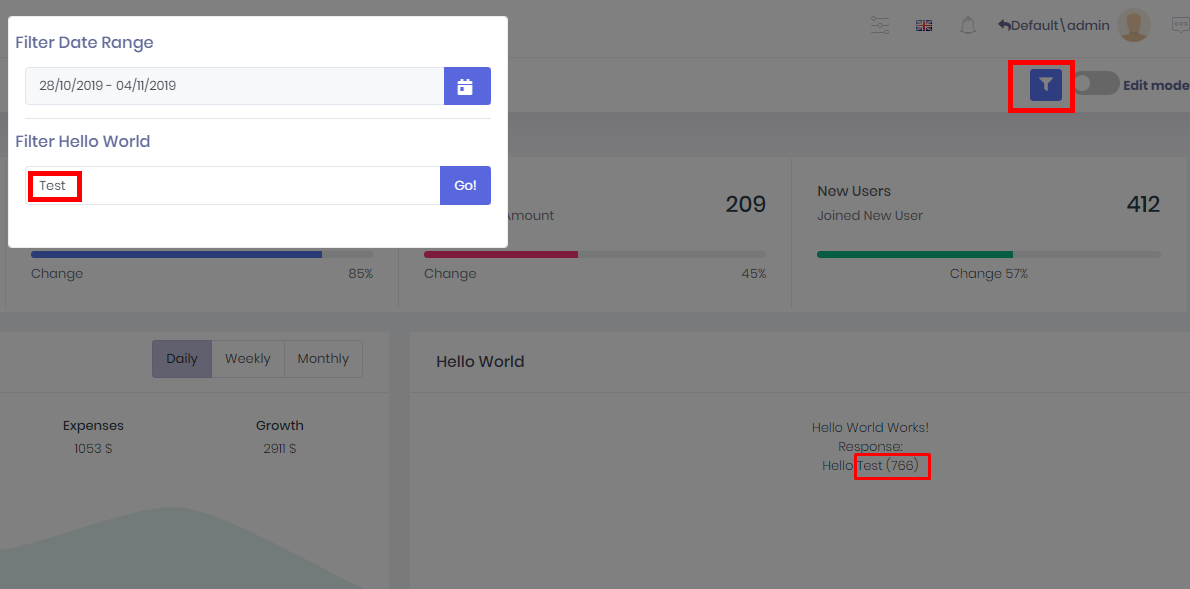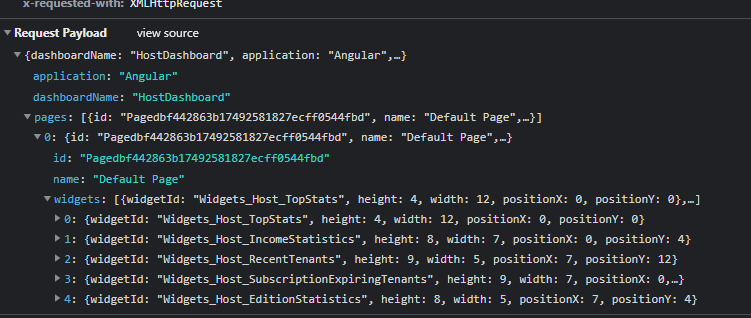Customizable Dashboard
You can create new widgets and widget filters for the customizable dashboards.
Let's create a new widget and widget filter step by step.
Pre-Note: Customizable dashboard configurations are stored in two places.
- Definitions which include permission, multitenancy side, etc. which should be controlled by the server are located in
*.Core -> DashboardCustomization -> Definitions -> DashboardConfiguration.csso that application layer can handle permission and other stuff. - View side definitions like component are located in the angular project.
- UI applications get data from the server about the dashboard and use their view information to show it.
Creating a New Widget Filter
Our widget filter name will be FilterHelloWorld . It will have one input and button and it will trigger an event when that input changed.
Step 1. Create Filter View
Open angular project.
Go to src\app\shared\common\customizable-dashboard\filters and create a new component.
> ng generate component filter-hello-worldChange component items as seen below.
filter-hello-world-component.html
<div class="form-group">
<div class="input-group">
<input type="text" class="form-control" #inputFilterHello placeholder="{{'SearchWithThreeDot' | localize}}">
<div class="input-group-append">
<button class="btn btn-primary" (click)="publishName(inputFilterHello.value)" type="button">Go!</button>
</div>
</div>
</div>
filter-hello-world-component.ts
import { Component, Injector } from '@angular/core';
import { AppComponentBase } from '@shared/common/app-component-base';
@Component({
selector: 'app-filter-hello-world',
templateUrl: './filter-hello-world.component.html',
styleUrls: ['./filter-hello-world.component.css']
})
export class FilterHelloWorldComponent extends AppComponentBase {
constructor(injector: Injector) {
super(injector)
}
publishName(name: string): void {
abp.event.trigger('app.dashboardFilters.helloFilter.onNameChange', name);
}
}
Step 2. Define Widget Filter
View Definitions
Widget's/widget filter's view consts are located in src\app\shared\common\customizable-dashboard.DashboardCustomizationConsts.ts Open *DashboardCustomizationConsts.ts create new id for hello world filter. (This id is also used in view page so be careful when selecting this value. It should not start with a number or special characters, etc.)
export class DashboardCustomizationConst {
...
static filters = {
filterDateRangePicker: "Filters_DateRangePicker",
filterHelloWorld: "Filters_HelloWorld"//add new id
};
...
}
Go to dashboard-view-configuration.service.ts. Add your new widget filter's view definition.
export class DashboardViewConfigurationService {
...
let filterHelloWorld = new WidgetFilterViewDefinition(
DashboardCustomizationConst.filters.filterHelloWorld,
FilterHelloWorldComponent//the component of filter
);
this.widgetFilterDefinitions.push(filterHelloWorld);
...
}
Server Side Definition
Open server project.
Open *.Core.Shared -> [YourAppName]DashboardCustomizationConsts.cs and define the same id in here too.
public class [YourAppName]DashboardCustomizationConsts
{
...
public class Filters
{
...
public const string HelloWorldFilter = "Filters_HelloWorld";
...
Go to *.Core -> DashboardCustomization -> Definitions -> DashboardConfiguration.cs and add hello world filter definition.
public class DashboardConfiguration
{
public DashboardConfiguration()
{
...
var helloWorldFilter = new WidgetFilterDefinition(
AbpZeroTemplateDashboardCustomizationConsts.Filters.HelloWorldFilter, "FilterHelloWorld");//localized string key
WidgetFilterDefinitions.Add(helloWorldFilter);
...
Now your filter is available for all widgets. You can use it in any widget definition and it will be loaded to page automatically.
Creating a New Widget
Our widget name will be WidgetHelloWorld
Step 1. Create an API
- Create an API which your widgets needs. In this scenario, We will create one endpoint into
TenantDashboardAppService.csnamedGetHelloWorldData.
public class GetHelloWorldInput
{
public string Name { get; set; }
}
public class GetHelloWorldOutput
{
public string OutPutName { get; set; }
}
public interface ITenantDashboardAppService : IApplicationService
{
...
GetHelloWorldOutput GetHelloWorldData(GetHelloWorldInput input);
...
}
public class TenantDashboardAppService ...
{
...
[AbpAuthorize(AppPermissions.HelloWorldPermission)]//check permission
public GetHelloWorldOutput GetHelloWorldData(GetHelloWorldInput input)
{
return new GetHelloWorldOutput()
{
OutPutName = "Hello " + input.Name + " (" + Clock.Now.Millisecond + ")"
};
}
...
}
Although ASP.NET Zero load widgets by filtering permission and other things. We still have to check permission here.
- After you create an API, run
*Web.Hostproject then go to nswag folder in angular project. Open any terminal and run resfresh.bat
Step 2. Create Widget View
Open angular project.
Go to src\app\shared\common\customizable-dashboard\widgets and create a new component.
> ng generate component widget-hello-worldChange component items as seen below..
widget-hello-world-component.html
<div class="kt-portlet kt-portlet--height-fluid">
<div class="kt-portlet__head">
<div class="kt-portlet__head-label">
<h3 class="kt-portlet__head-title">
Hello World
</h3>
</div>
</div>
<div class="kt-portlet__body">
Hello World Works! <br/>
Response: {{helloResponse}}
</div>
</div>
widget-hello-world-component.ts
import { Component, Injector } from '@angular/core';
import { AppComponentBase } from '@shared/common/app-component-base';
import { TenantDashboardServiceProxy } from '@shared/service-proxies/service-proxies';
@Component({
selector: 'app-widget-hello-world',
templateUrl: './widget-hello-world.component.html',
styleUrls: ['./widget-hello-world.component.css']
})
export class WidgetHelloWorldComponent extends WidgetComponentBase implements OnInit, OnDestroy {
helloResponse: string;
constructor(injector: Injector,
private _tenantDashboardService: TenantDashboardServiceProxy) {
super(injector);
}
ngOnInit(): void {
this.subHelloWorldFilter();
this.runDelayed(()=>{
this.getHelloWorld("First Attempt");
});
}
getHelloWorld = (name: string) => {
this._tenantDashboardService
.getHelloWorldData(name)
.subscribe((data) => {
this.helloResponse = data.outPutName;
});
}
onNameChange = (name) => {
this.runDelayed(()=>{
this.getHelloWorld(name);
});
}
subHelloWorldFilter() {
abp.event.on('app.dashboardFilters.helloFilter.onNameChange', this.onNameChange);
}
unSubHelloWorldFilter() {
abp.event.off('app.dashboardFilters.helloFilter.onNameChange', this.onNameChange);
}
ngOnDestroy(): void {
this.unSubHelloWorldFilter();
}
}
Step 3. Define Widget
View Definitions
Widget's/widget filter's view consts are located in src\app\shared\common\customizable-dashboard\DashboardCustomizationConsts.ts Open *DashboardCustomizationConsts.ts create new id for hello world widget. (This id is also used in view pages so be careful when selecting this value. It should not start with a number or special characters, etc.)
export class DashboardCustomizationConst {
static widgets = {
tenant: {
...
helloWorld: "Widgets_Tenant_HelloWorld"
},
...
}
Go to src\app\shared\common\customizable-dashboard\dashboard-view-configuration.service.ts. Add your hello world widget's view definition.
export class DashboardViewConfigurationService {
...
//add your tenant side widgets here
let helloWorld = new WidgetViewDefinition(
DashboardCustomizationConst.widgets.tenant.helloWorld,
WidgetHelloWorldComponent,
)
this.WidgetViewDefinitions.push(helloWorld);
...
}
Server Side Definition
Open server project.
Open ``*.Core.Shared -> [YourAppName]DashboardCustomizationConsts.cs` and define the same id in here too.
public class [YourAppName]DashboardCustomizationConsts
{
public class Widgets
{
public class Tenant
{
public const string HelloWorld = "Widgets_Tenant_HelloWorld";
...
Go to *.Core -> DashboardCustomization -> Definitions -> DashboardConfiguration.cs and add hello world widget's definition.
public class DashboardConfiguration
{
public DashboardConfiguration()
{
...
var helloWorld = new WidgetDefinition(
id:AbpZeroTemplateDashboardCustomizationConsts.Widgets.Tenant.HelloWorld,
name:"WidgetRecentTenants",//localized string key
side: MultiTenancySides.Tenant,
usedWidgetFilters: new List<string>() { helloWorldFilter.Id },// you can use any filter you need
permissions: tenantWidgetsDefaultPermission);
helloWorld.Permissions.Add(AppPermissions.HelloWorldPermission);
...
...
var defaultTenantDashboard = new DashboardDefinition(
AbpZeroTemplateDashboardCustomizationConsts.DashboardNames.DefaultTenantDashboard,
new List<string>()
{
generalStats.Id, dailySales.Id, profitShare.Id, memberActivity.Id, regionalStats.Id, topStats.Id, salesSummary.Id, helloWorld.Id //add your widget to dashboard
});
...
Since we create component with ng generate command our component will be automatically added to app-common.module.ts declarations. Customizable dashboard loads component dynamically, that's why we also add our components to entryComponents.
Go to app-common-module.ts and add FilterHelloWorldComponent and WidgetHelloWorldComponent
@NgModule({
...
entryComponents: [
...
FilterHelloWorldComponent,//add filter
WidgetHelloWorldComponent//add widget
]
})
export class AppCommonModule {
static forRoot(): ModuleWithProviders {
return {
ngModule: AppCommonModule,
providers: [
AppAuthService,
AppRouteGuard
]
};
}
}
After that you will be able to use your new widget.
Resize Event
You can subscribe to resize event of a widget. This event is triggered when a widget is resized. You can use this event to update your widget's content.
import { Inject } from '@angular/core'; //import inject
import { WidgetOnResizeEventHandler, WIDGETONRESIZEEVENTHANDLERTOKEN } from '../../customizable-dashboard.component'; // import WidgetOnResizeEventHandler and WIDGETONRESIZEEVENTHANDLERTOKEN from customizable-dashboard.component
@Component({
//...
})
export class YOURCOMPONENT extends WidgetComponentBaseComponent {
//...
constructor(
//...
@Inject(WIDGETONRESIZEEVENTHANDLERTOKEN) private _widgetOnResizeEventHandler: WidgetOnResizeEventHandler //inject resize event handler
) {
//...
//It will be triggered for the one which was resized even if you have multiple YOURCOMPONENT in your page.
_widgetOnResizeEventHandler.onResize.subscribe(() => {
//todo: reload graph or something.
console.log('resize completed');
});
}
}
Usage
Since we create tenant side widget, open tenant dashboard.
Select the page you want to use hello widget.
Add hello widget to the page as described in that article: Customizable Dashboard Usage
After that, you will see that your widget is located on the page and works as expected.
Since hello world widget needs hello world filter (we defined it in DashboardConfiguration) hello world filter will be loaded to the page. To use it. Click the filter button next to the Edit Mode button. It will open the filter modal.
As you can below, you will be able to see filters that your widgets need. Change input and click Go. Hello world widget will be changed by your filter.
Changing Default Dashboard View
AspNet Zero uses angular-gridster2 grid system in dashboard and stores needed view data in app settings. To change default view of dashboard you should change related part of the settings located in AppSettingProvider. To change default dashboard view you should open dashboard and design the dashboard by following the document . Then open browser's developer console. Click to the save button in the page and follow the request named SavePage.
Open the request payload and get the data from there
Then go to AppSettingProvider's GetDefaultAngularDashboardViews method and change the information with using the data you get from request payload.




